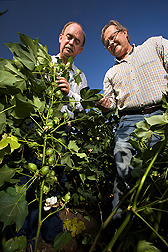Read the
magazine
story to find out more.
|

ARS Plant geneticist Richard Percy and ARS plant
physiologist Steven Crafts-Brandner are working to differentiate between cotton
plants that are heat avoidant and those that are heat tolerant, which is a more
desirable trait. Click the image for more information about it.
|
|

|
Breeding Heat-Tolerant Cotton
By Laura
McGinnis
February 19, 2008 Some plants like it hot. Cotton
with superior heat tolerance can be a profitable crop for warmer climates, so
Agricultural Research Service (ARS)
scientists are identifying tolerance-specific genetic selection tools to assist
breeding efforts.
Unfortunately, it's nearly impossible to differentiate between heat
tolerance and heat avoidance simply by examining the quantity and
quality of final crop yields. Heat avoidance refers to characteristics that
enable a plant to withstand the heat with similar, but less reliable,
results—for example, by shifting the bulk of metabolic activity to cooler,
evening periods.
At the
U.S.
Arid-Land Agricultural Research Center in Maricopa, Ariz., ARS scientists
are investigating the process known as "dark respiration." This
research could make it easier to differentiate between heat-tolerant and
heat-avoidant plants.
Dark respiration is a continuous process in which mitochondria within a
plant's cells oxidize carbohydrates to create energy. Cotton plants make more
starch during the day than they require for growth. The excess starch is stored
in plant cells' chloroplasts, where photosynthesis occurs. At night, that
starch is broken down via respiration and other metabolic processes and used to
support new growth, such as cotton bolls.
To determine the relationship between efficient nocturnal carbon use and
heat tolerance, plant physiologist
Steven
Crafts-Brandner and plant geneticist
Richard
Percy—now with the
ARS
Southern Plains Agricultural Research Center in College Station,
Texas—selected three upland and three pima cotton cultivars, choosing a
mix of heat-tolerant and heat-susceptible plants. They have been monitoring the
cultivars' rates of dark respiration and photosynthesis throughout the day.
Percy and Crafts-Brandner have already made some significant observations.
For example, the cultivars with the greatest heat tolerance generally have
lower rates of dark respiration and more efficient use of carbohydrates. If
ongoing studies support these observations, the scientists may be able to use
these traits to improve the cotton breeding program.
ARS is the U.S. Department of
Agriculture's chief scientific research agency.